What is Upptime?
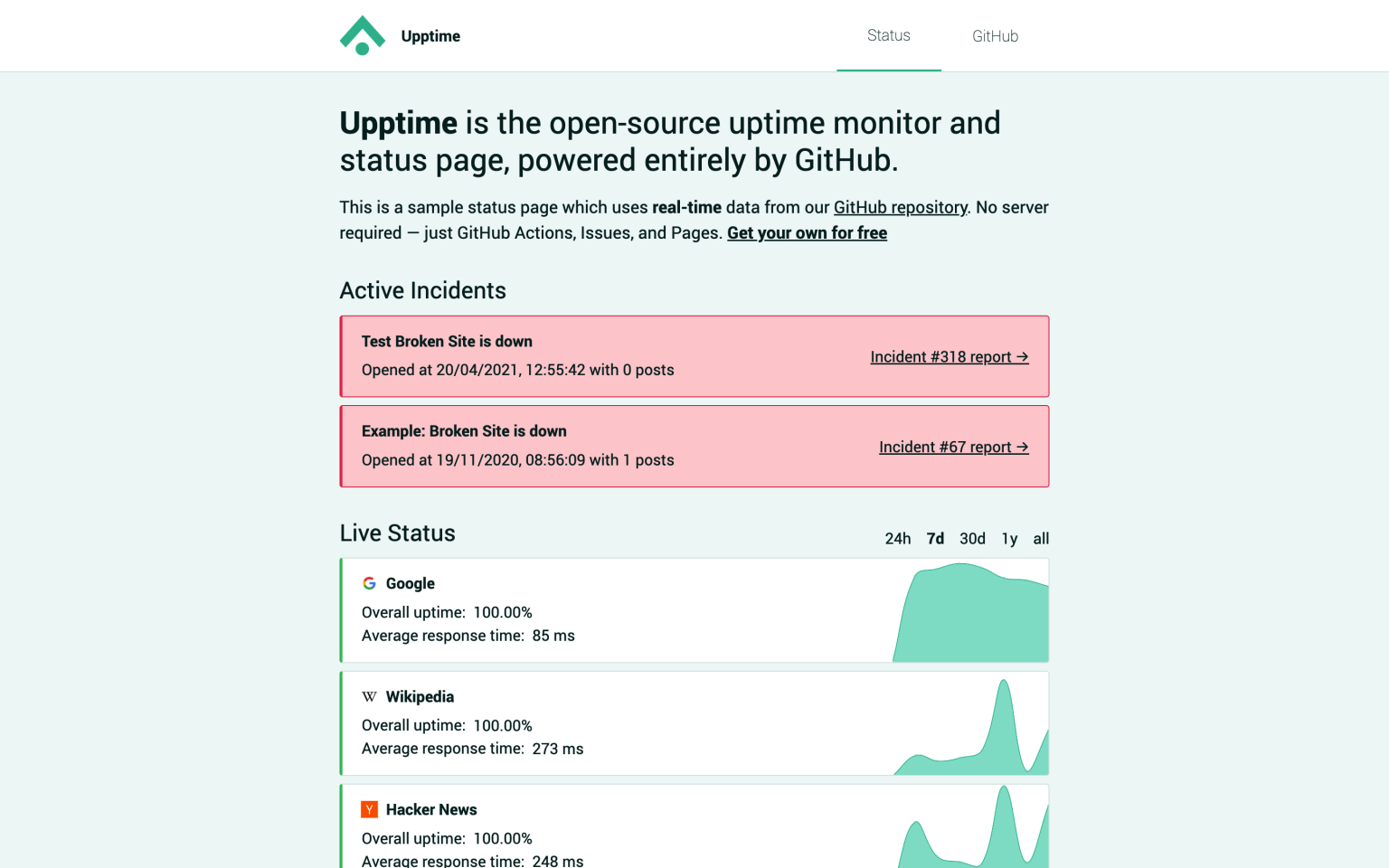
Upptime is an uptime monitoring tool and status page provider. It’s open source and is powered entirely by GitHub.
Upptime enables users to schedule workflows to run automatically in pre-set time intervals using GitHub Actions. Upptime checks your website every 5 minutes, and your website status data is reflected on the appropriate status page.
Another interesting feature is that once a day, Upptime generates a graph of your website’s response time. With this, you can easily see and broadcast your long-term statistics.
Lastly, Upptime offers customization features for your status page. It includes changing logos, copy, graphs, and more. Users get to personalize the status page according to their website’s theme and colors.
Compared to its alternatives, Upptime is open source and free, as well as highly flexible when it comes to customization. If you are seriously considering Upptime, check the report on GitHub’s reliability, since Upptime users depend on it.
Benefits of Upptime
- No server is needed, as the service runs from a GitHub repository (template available)
- Free and open-source software
- Great design (themes available)
- Plenty of functionality
- Efficient status updates (every 5 minutes)
- Flexible in regards to customization and personalization

Why Would I Need an Upptime Alternative?
The two key reasons to check out some Upptime alternatives are:
- Upptime runs from GitHub
- No status page subscriptions
As a result, it’s worth knowing what other options you have. To find out more about Upptime alternatives, look through our breakdown below.
Upptime Alternative #1 – StatusGator
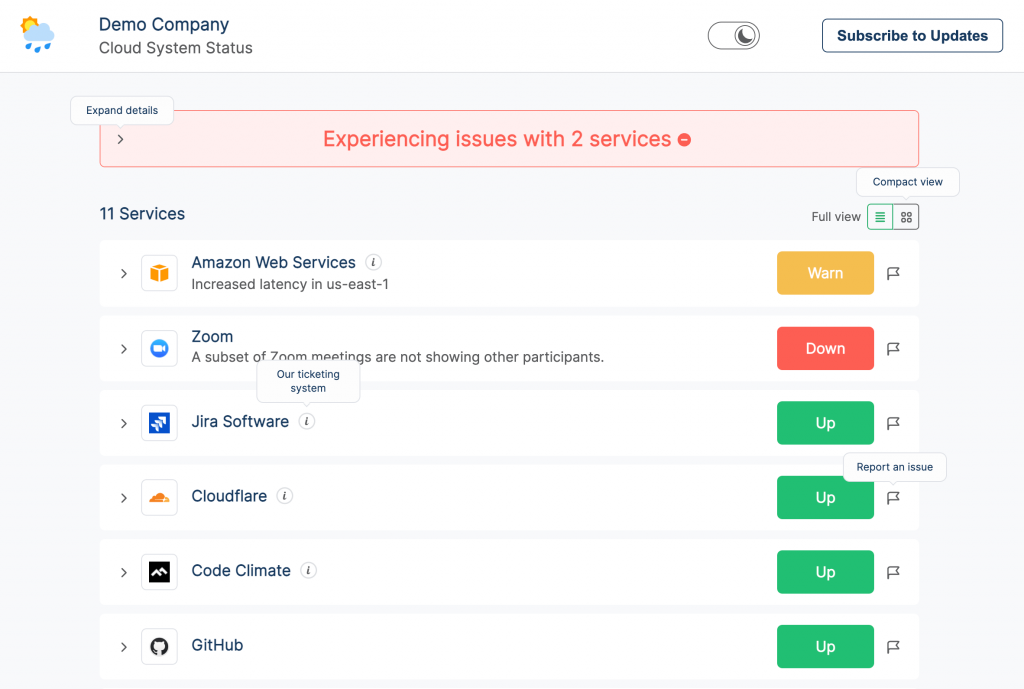
Our first and most recommended choice for an alternative to Upptime has to be StatusGator. StatusGator is not a typical status page provider or Upptime alternative. As StatusGator offers the basics you need for a status page, it also offers a unique service – status aggregation from 2,700 cloud services and counting.
StatusGator allows you to not only communicate your internal services’ statuses but also the statuses of all your cloud dependencies. It includes hosting, payment gateways, critical APIs, and other third-party cloud services.
By aggregating and normalizing all your status data together, StatusGator allows you to directly monitor your own services and the providers you depend on on a single unified status page. This powerful combination makes it the ideal tool for internal team and IT status pages. This is not something offered by other common Upptime alternatives.
StatusGator vs. Upptime
The key difference between StatusGator and Upptime is that StatusGator can aggregate the status of any cloud service (such as AWS, Zoom, Microsoft 365, etc.) or a website into a single status page.
It also has a direct monitoring feature to monitor internal tools, including your own website and other services without status pages.
In contrast, Upptime only offers uptime monitoring as well as basic status page functionality and personalization. Whilst this is beneficial, StatusGator can offer something unique.
Overall, StatusGator is certainly unique and can offer a lot more than basic status page functionality. Whilst not free like Upptime, it is much more versatile and flexible.
Benefits of StatusGator
- 3,000+ cloud services statuses on your status page
- Website monitoring built-in: No third-party tool is needed.
- Custom domain, logo, and favicon upload
- Branding removal and white-label status page
- Password protection
- 2FA and SSO
- Hassle-free setup in minutes
- Free plan on a public status page and a free trial as part of all plans.
Upptime Alternative #2 – Cachet
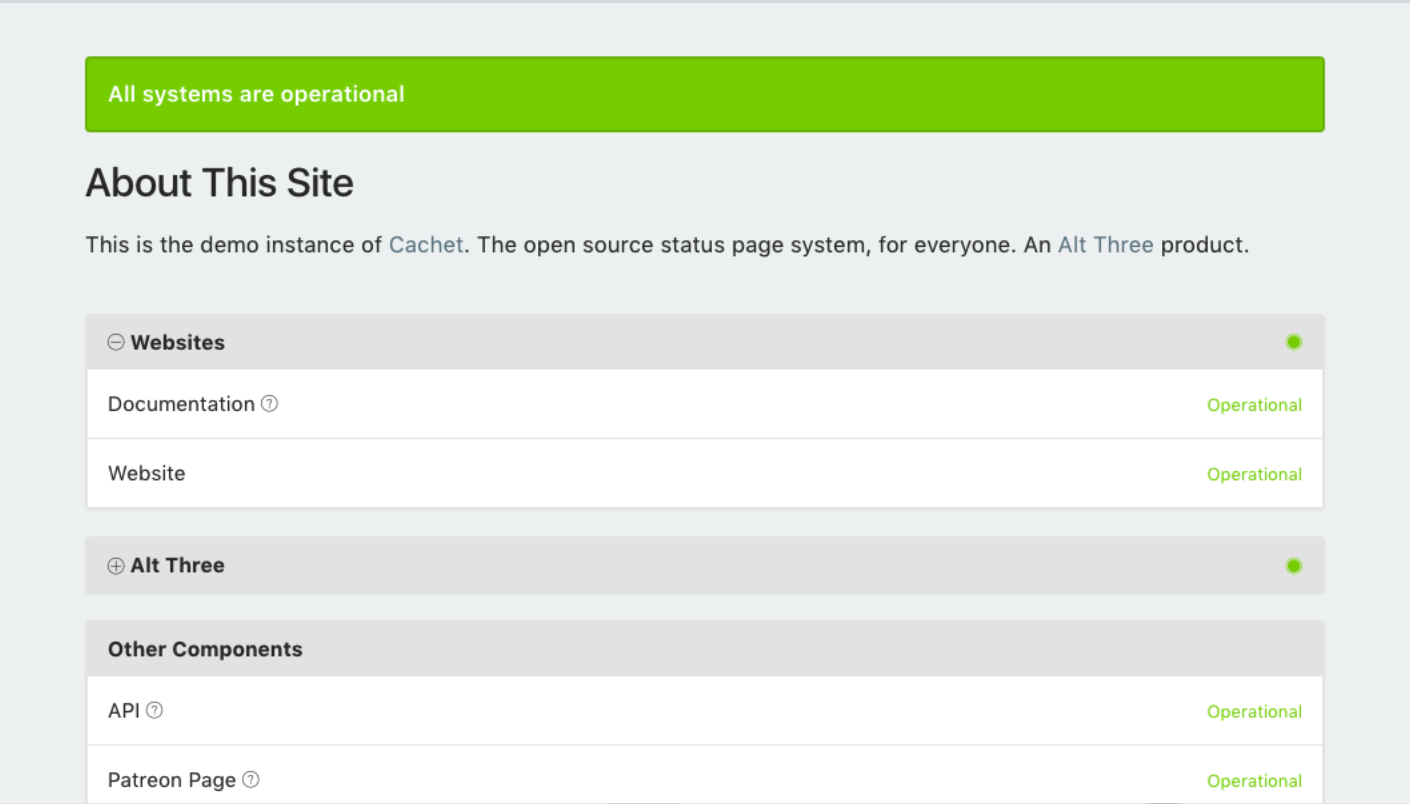
Cachet is widely known and used by many teams worldwide. Just like Upptime, it is an open-source status page system, but it is made using Bootstrap 3 – allowing for a responsive design.
It’s an impressive Upptime competitor, as Cachet offers basic uptime monitoring that is displayed on a dashboard that is clear and straightforward. With Cachet’s API, you can easily set up any metrics you want on the dashboard, be it uptime, error rates, or response times. Cachet also has the option to schedule maintenance.
These features can greatly boost transparency between your services and their users when taken advantage of. Also, Cachet can be a great choice for anyone looking for extra security, as they offer two-factor authentication with the Google Authenticator app. However, there are prerequisites to installing Cachet – something to keep in mind.
Cachet vs. Upptime
Overall, Cachet is free and customizable in many ways, as it is an open-source service. This is also the case with Upptime, and Cachet does share similarities with Upptime. They are both GitHub compatible, and both have their limitations (No private statuses, no third-party monitoring, etc.) and so do not differ too much.
However, one feature Cachet has and Upptime doesn’t is the additional security factor. Two-factor authentication and password protection are available. Also, documentation is considered better than that of Upptime.
Additionally, Cachet’s UI is outstanding with its dashboard. Cachet’s Slack community might help with any arising issues. Overall, Cachet is more similar to Upptime than most other Upptime alternatives, but it is still a strong competitor nonetheless – and it’s definitely worth considering.
Benefits of Cachet
- Free and Open Source
- Customizable with built-in tools for status page personalization
- Enables user to display any metric on an easy-to-use dashboard
- 2FA (Two-factor authentication) is compatible with the Google Authenticator App
- Multiple languages are available
- Slack community
- Outstanding with its excellent chart dashboard.
Upptime Alternative #3 – Instatus
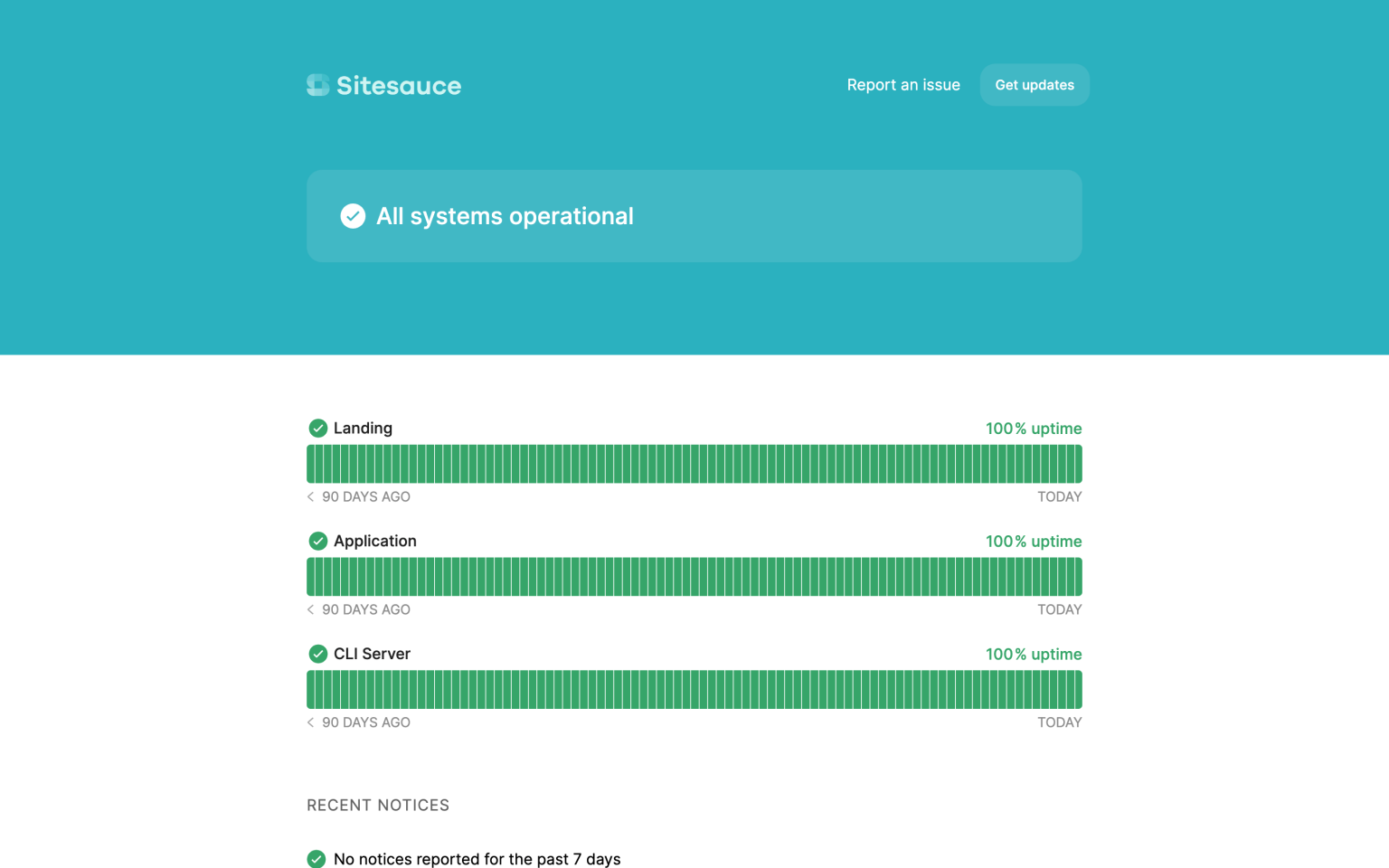
Instatus is a more recent status page provider that has become widely used, but nevertheless, it is still a strong competitor to Upptime and is a good alternative.
Firstly, Instatus offers a free status page with unlimited subscribers and unlimited teams. Secondly, Instatus’ features are what you would expect – email subscriptions, scheduled maintenance, incident templates, API, and integration with incident management tools (e.g. PagerDuty). It could be a good option for you if you are wanting a low-priced yet flexible alternative to Upptime.
However, the catch is that the custom domain, and private status page are billed additionally.
Instatus vs. Upptime
Both Instatus and Upptime are free, it’s important to note that a custom domain only becomes available for Instatus on a paid plan starting at $20 per month. Instatus has separate pricing on private and public pages – so it really depends on your needs and what you require. On the other hand, Upptime does not offer to subscribe to status pages but it is free. In a nutshell, the difference comes with the rates and what you want from the service.
Overall, Instatus is a very well-designed tool that offers basic status page functionality similar to Upptime. However, It focuses on distinguishing itself from others, mainly with reasonable pricing for smaller teams and businesses whilst also offering more features and flexibility than Upptime.
Benefits of Instatus
- Allows users to add status widgets on the website
- Price does not depend on the number of subscribers – subscriptions are unlimited
- Clean and simple design
- API and integrations with incident management tools like PaperDuty.
Upptime Alternative #4 – Status.io
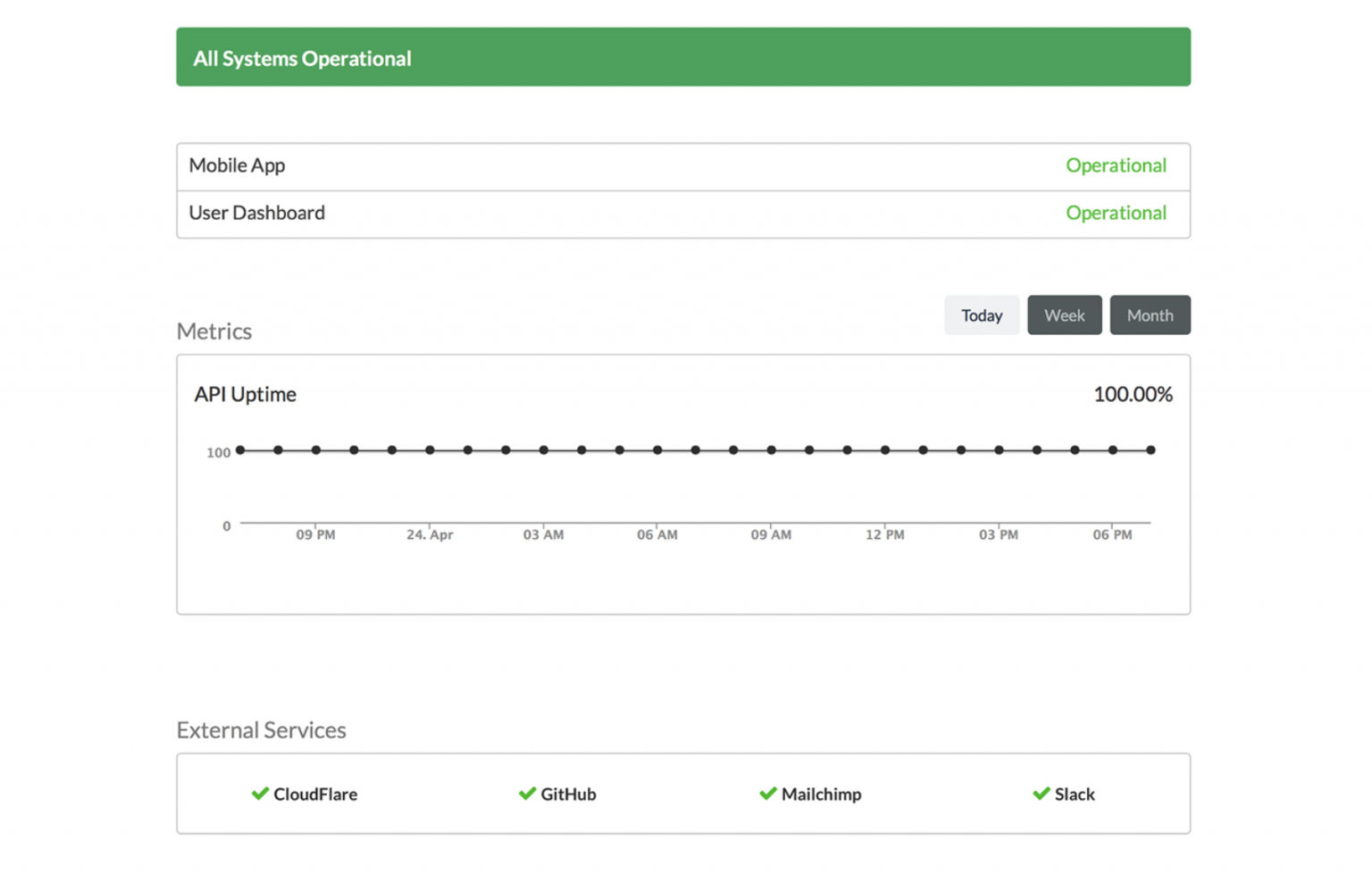
Status.io, like other providers, offers a status page system for your app or web service. Status.io’s features include customizable incident tracking, subscriber notifications, and much more.
As for technical details, the infrastructure of Status.io is powered by multiple systems located in different corners of the world. All status pages include a unique API method, meaning developers can retrieve the current status easily. It also includes complete control for complex distributed systems and multi-tenant infrastructure.
Users can add elements of their brands and tweak the code to tailor their status page in line with their brand or website theme. In addition to personalization, Status.io offers users an extra status page for testing, which can be very useful for experimenting with code or display.
In short, Status.io can offer:
- Display of performance monitoring metrics
- Subscriber notifications
- Data sharing with multiple tools
- Link monitoring tools for status automation
- Twitter broadcasts.
Status.io vs. Upptime
Status.io offers paid plans, so either way, it is more costly than the free status page that Upptime can provide. However, different plans come with different features, and Status.io can be cheaper than some Upptime alternatives overall (such as StatusPage.io).
Status.io includes a private status page and third-party status display in its plan, which can be of benefit to users. However, it is not clear how many third parties are available (StatusGator offers more than 2,770 providers).
Overall, Status.io is a strong provider with customization options and impressive reliability, but may not be the most cost-efficient service compared to Upptime.
Benefits of Status.io
- Automatic notifications on the current status of the appropriate component triggered by updates
- Maintenance scheduling
- Metric display via Custom Metric API or external data source
- Customizable
- SSO and access control based on IP.
Upptime Alternative #5 – Better Uptime
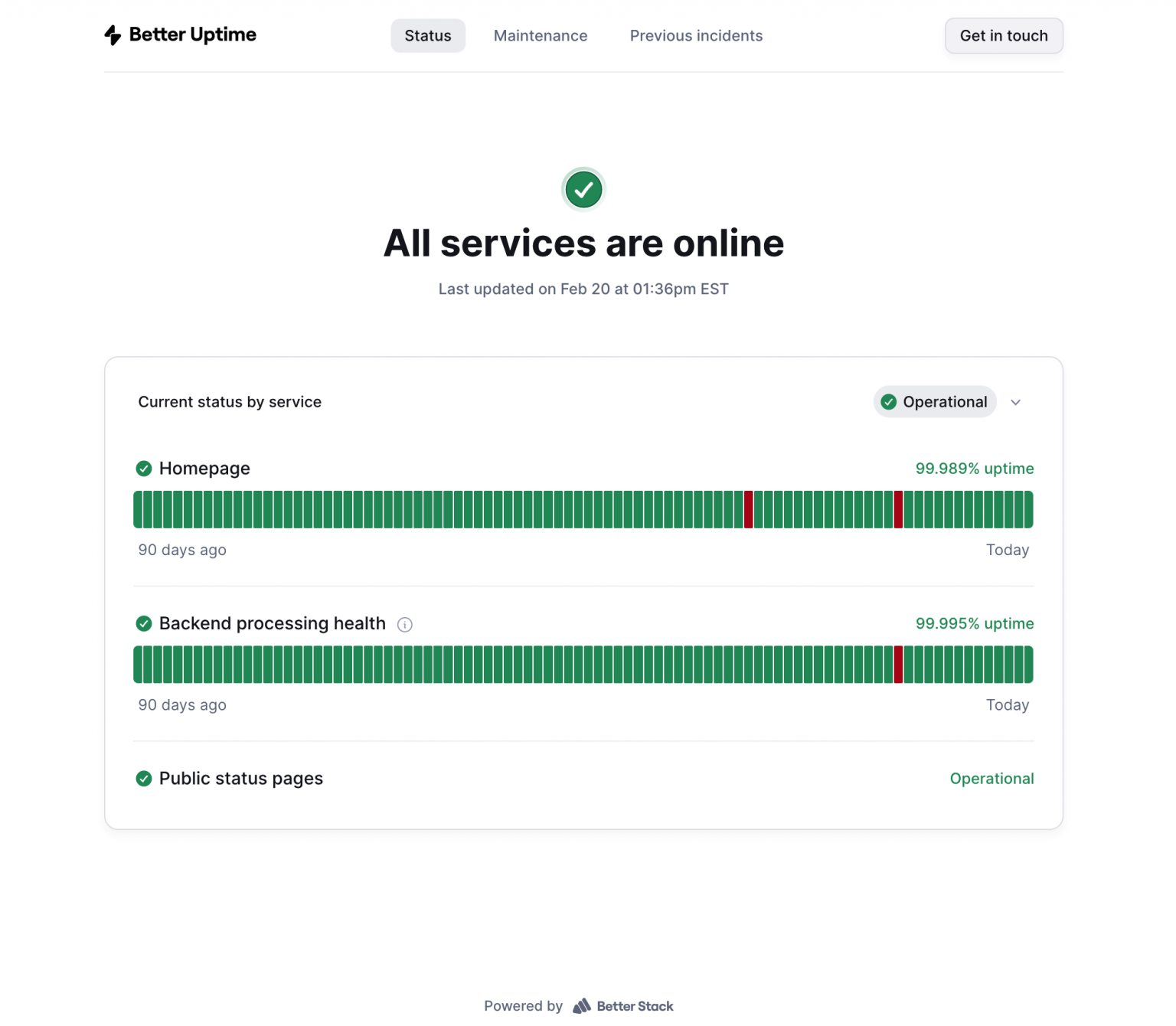
Better Uptime is another strong competitor to Upptime, as it offers incident management, uptime monitoring, and status pages into a single product. It’s a very well-known status provider and is used worldwide by teams and businesses.
But what does it offer? Firstly, their incident management system offers easy-to-use, on-call calendar scheduling. Similar to PagerDuty, there are advanced team management and access features available. There are also options to integrate with Slack and Microsoft Teams.
When it comes to alerting, Better Uptime offers unlimited phone calls and SMS alerts on all paid plans. In addition, you can embed incident screenshots and debugging information directly into alerts.
The main benefit of Better Uptime, however, is that it has built-in synthetic monitoring via:
- HTTP(s)
- Ping
- SSL&TLD expiration
- Cron job
- Port monitoring.
Something else that is worth noting is that the monitors can be integrated with the on-call alerting system. This can be done without needing to integrate any third-party monitoring tools, such as Pingdom or UptimeRobot.
Overall, when it comes to integrations, Better Uptime offers a wide range of monitoring and analytical integrations that are ideal for more demanding users. It’s a strong competitor to Upptime, as Better Uptime offers both status page functionality and monitoring.
Better Uptime vs. Upptime
Overall, Better Uptime offers a free status page that is simple and easy to use, just like Upptime. However, it is connected to all existing monitors and can be edited in seconds without using GitHub. Also, status pages can be fully customized and published on a custom domain.
Paid plans allow users to set up password-protected pages, as well as e-mail and API status subscriptions. It means that for some more useful features, you have to pay. That said, it provides you with that flexibility that Upptime does not.
Benefits of Better Uptime
- Free status page for all users on a custom domain
- Uptime monitoring built-in
- Embeddable system status notice
- Integration with StatusGator provides additional visibility into the statuses of all of your vendors
- Widget for the website.
Upptime Alternative #6 – Statuspage.io
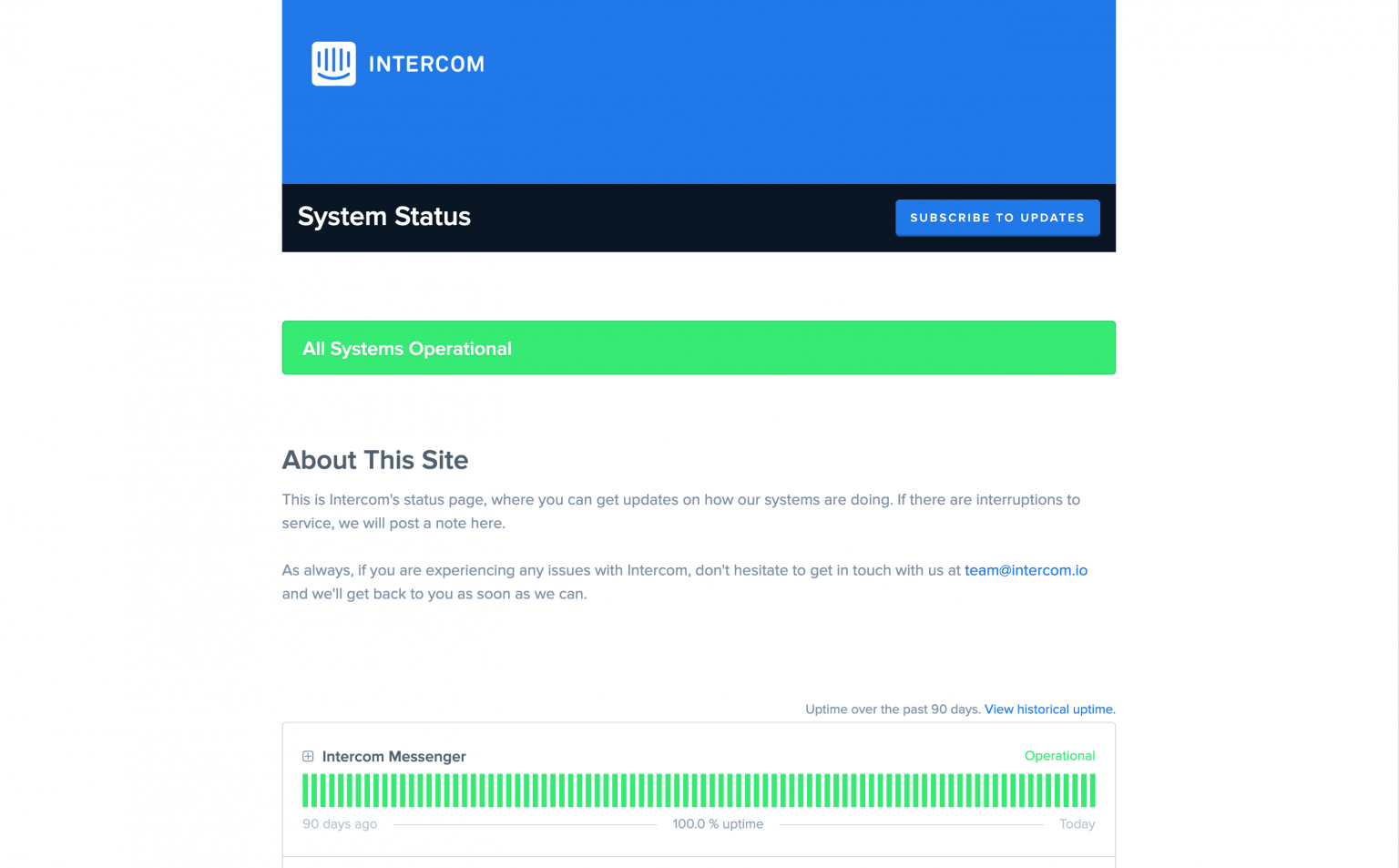
Statuspage.io is a common communication tool, but not a monitoring tool. It is easily one of the most popular status providers out there and is used by thousands.
Statuspage.io offers both public and private status page services, and so has different pricing. There is also separate pricing for audience-specific pages. It also offers a custom domain as well as other status page functionality features you would expect.
Statuspage.io vs Upptime
Both Upptime and Statuspage.io can be used for free, but the free plan offered by Statuspage.io is limited. You can only get CSS on paid plans, as well as other features. As mentioned, it also offers public and private services, both of which have different pricing.
So, in conclusion, the difference once again comes down to rates and also what you require from the service. Compared to other Upptime competitors and alternatives, Statuspage.io is known for higher pricing.
Benefits of StatusPage.io
- Custom Domain
- 30 Second interval checks
- Free plan and status page
- Password protection
- CSS on paid plans
Upptime Alternative #7 – Uptime Robot
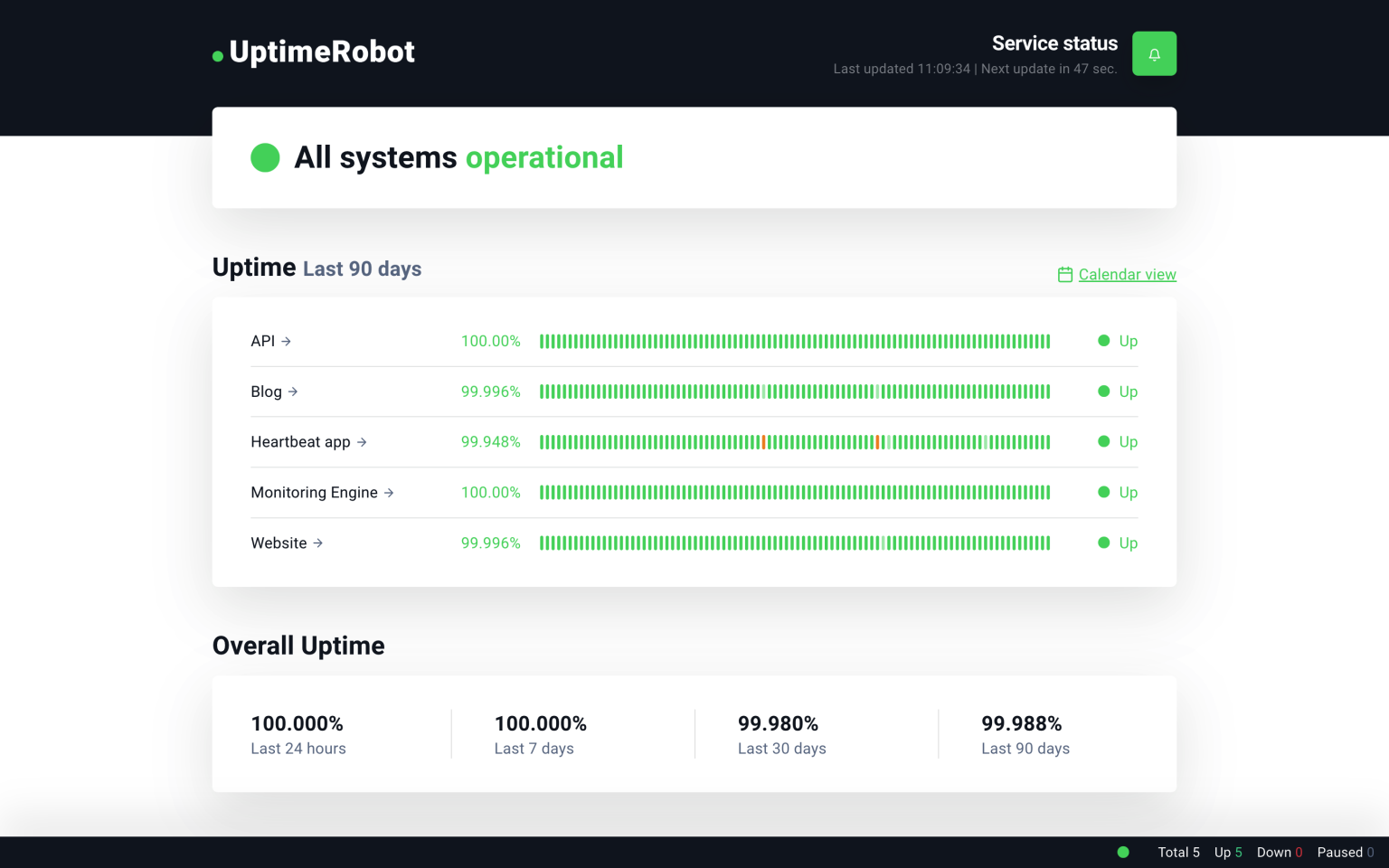
Uptime Robot is primarily an uptime monitoring service and started to offer a very basic status page on its free plan recently. However, white-label unlimited status pages become available with a Team plan at $29 per month, charged annually.
The main thing to note about Uptime Robot is that the free plan includes setting up 50 monitors, and being able to perform monitoring for the following:
- Website
- SSL
- Ping
- Port
- Cron
- Keyword monitoring.
Uptime Robot can be an alternative to Upptime, if you want to spend less time setting up and dealing with GitHub. And of course, if you have the budget for it.
UptimeRobot vs. Upptime
The key difference between Upptime and Uptime Robot is that the latter offers unlimited white-label status pages only with a paid plan. On the other hand, Upptime is a free, open-source service. Status pages are secondary in the services provided by UptimeRobot, while uptime monitoring is their primary product.
Overall, however, its paid plans offer a range of features and flexibility, so it’s still a strong Upptime competitor – depending on your needs.
Benefits of UptimeRobot
Some key benefits of UptimeRobot are:
- Users can set up maintenance windows to inform subscribers about planned maintenance
- 10-day money-back guarantee if their plan does not work for you
- 50 monitors on its free plan
Comparing Upptime to Alternative Status Page Providers
| Criteria | StatusGator | Statuspage | Better Uptime | Cachet | Instatus | Status.io | UptimeRobot | Upptime |
|---|---|---|---|---|---|---|---|---|
| Primary category | communication, monitoring, aggregation | communication | monitoring | communication | communication | communication | monitoring | monitoring |
| Key differences | ||||||||
| Private status page | ✅ On all plans | From $79/month | From $200/month | ❓ | For $50/month | For $349/month | For $348/month | ❓ |
| Components display | ✅ | ✅ | ❓ | ✅ | ✅ | ✅ | ❓ | ❓ |
| Website monitoring | ✅ | ❌ | ✅ | ❌ | ❌ | ❌ | ✅ | ❌ |
| Monitoring - third-party service statuses | 2,800+ | 200 | ❌ | ❌ | 168 | 170 | ❌ | ❌ |
| Trial | ✅ | ❌ | ❌ | ❌ | Only on private pages | ❌ | ❌ | ❌ |
| Cost per month | Starts at $72 | Starts at $29 | Starts at $30 | Free | Starts at $20 | Starts at $79 | Starts at $7 | Free |
| Status page features | ||||||||
| Hosted | ✅ | ✅ | ✅ | self-hosted | ✅ | ✅ | ✅ | ✅ |
| Favicon | ✅ | ✅ | ❓ | ✅ | ✅ | ✅ | ❓ | ✅ |
| CSS | ✅ | On paid plans | ✅ | ✅ | ✅ | ✅ | ❓ | ✅ |
| Branding removal | ✅ | ❓ | ❓ | ❓ | ❓ | On Standard plan and higher | On PRO plan and higher | ❓ |
| Components display | ✅ | ✅ | ❓ | ✅ | ✅ | ✅ | ❓ | ❓ |
| Subscribers to status pages | Unlimited | Limited | Limited. Available on higher plans only | Unavailable | Unlimited | Limited. Quantity depends on the plan | Limited. Available on higher plans only | Unavailable |
| Notifications | Email, SMS, Slack, MS Teams, Discord | Slack email, Webhook | Voice call, SMS, Mobile pushSlack, Microsoft Teams | SMS, Discord Slack, Twitter, Micrisoft teams, email | Twitter, SMS, voice call, Email, Slack, Discord Telegram | Email, SMS, voice call, Slack, Zapier, Twitter | Slack, Telegram, Webhooks |
|
| Password protection | ✅ | On Starter plan and higher | On Business plan and higher | ✅ | On Private PRO plan and higher | Authentication via SSO, SAML Identity Providers, IP Access control | ❓ | ❓ |
| Monitoring | ||||||||
| Ping interval | 5 min | 30 sec | 3 min or 30 sec on Freelancer plan and higher | ❓ | ❓ | ❓ | 5 min or 1 min on PRO plan | 5 min |
| General | ||||||||
| Documentation | Great | Good | Good | Great | OK | OK | OK | Good |
| Support | Contact form, email, chat | Contact form | Email, chat, phone | Email, Help with installation $249 | Chat, email | Chat | GitHub | |
| Account security | 2FA, SSO | 2FA, G Suite and SAML single sign-on | 2FA, GDPR, SSO on Enterprise plan | 2FA | SSO / SAML on Business plan | 2FA with Yubikey,Custom TLS / SSL Certificate, IP filtering, | 2FA | ❓ |
FAQ on the Best Upptime Alternatives
Q: Who are the main Upptime competitors?
A: StatusGator is the key competitor to Upptime, as StatusGator offers a unique and efficient approach to status monitoring. On top of this, there is also an internal monitoring tool – so you have all bases covered with StatusGator. It combines all public and private status pages into one plan too, meaning you don’t need to worry about individual pricing.
Aside from StatusGator, other popular status page providers such as Cachet and Instatus are Upptime’s main competitors. Instatus is a strong competitor due to being a low-priced alternative that offers flexibility and multiple features that are beneficial for users. Cachet is free and open-source but requires hosting for a status page and a more extensive system setup before getting started.
Q: What is the best alternative to Upptime?
A: StatusGator – StatusGator is unique compared to other Upptime alternatives and offers a well-priced, efficient method of status monitoring. StatusGator aggregates all your status data of the cloud services you depend on into a single status page. There is also an internal monitoring tool so you can monitor the status of your own services. This, combined with the data aggregation method, goes a long way in transparency with users and covering all bases for monitoring your website or app.
Q: What are the alternatives to Upptime?
A: The key alternatives to Upptime are:
- StatusGator – A unique approach to status monitoring, using aggregation to display all status data on a unified status page. Internal monitoring tools are also available.
- Cachet – A good choice for those looking for extra security, as 2FA and password protection are available.
- Instatus – A well-priced alternative to Upptime with many flexible and versatile features.
- Status.io – Many features focused on users being able to personalize and customize their status page, which can go a long way for your brand.
- Better Uptime – A well-built incident management system as well as other useful features for status page functionality.
- Statuspage.io – one of the more widely used status providers. Many features are available on their free plan.
- UptimeRobot – A beneficial choice for those needing more than basic monitoring (up to 50 monitors available) and who are prioritizing uptime monitoring over status pages.

Alternatives for Better Communications by StatusGator
Recent Posts



